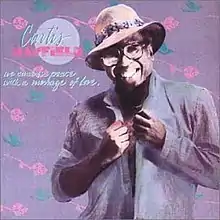| We Come in Peace with a Message of Love | ||||
|---|---|---|---|---|
 | ||||
| Studio album by | ||||
| Released | 1985 | |||
| Recorded | May–July 1984 | |||
| Studio | Curtom Recording Studio, Atlanta, Georgia | |||
| Genre | Funk, soul | |||
| Length | 37:51 | |||
| Producer | Curtis Mayfield, Norman Harris, Ron Tyson | |||
| Curtis Mayfield chronology | ||||
| ||||
| Review scores | |
|---|---|
| Source | Rating |
| AllMusic | |
| The Encyclopedia of Popular Music | |
| (The New) Rolling Stone Album Guide | |
We Come in Peace with a Message of Love is an album by the American musician Curtis Mayfield, released 1985.[4][5] The first single was "Baby It's You".[6] Mayfield recorded a new version of "We Got to Have Peace".[7]
Track listing
All songs written by Curtis Mayfield, except where noted.
| No. | Title | Writer(s) | Producer(s) | Length |
|---|---|---|---|---|
| 1. | "We Come in Peace" | Mayfield | 8:30 | |
| 2. | "Baby It's You" | Mayfield, Benny Scott, Edward Gregory, Joseph Scott | Mayfield | 5:48 |
| 3. | "Bodyguard" | Norman Harris, Ron Tyson | Mayfield | 4:41 |
| 4. | "Breakin' in the Streets" | Mayfield | 5:38 | |
| 5. | "Everybody Needs a Friend" | Mayfield | 4:51 | |
| 6. | "This Love is True" | Mayfield | 3:25 | |
| 7. | "We Got to Have Peace" | Mayfield | 4:40 |
Personnel
- Curtis Mayfield - vocals, guitar, Linn drum sequencing
- Edward Gregory, Joseph "Lucky" Scott, Bobby Eli, Norman Harris - guitar
- Tracy Mayfield, Joseph "Lucky" Scott, Jimmy Williams - bass
- William Green, Carlton Kent, Eugene Curry, Buzz Amaro - keyboards
- Theodis Rodgers - piano, Prophet V synthesizer
- Earl Young, Morris Jennings - drums
- Glen "Bongo" Davis, Master Henry Gibson - congas
- Hank Ford - saxophone
- Nella Rigell-Colson - harp
References
- ↑ "We Come in Peace With a Message of Love Curtis Mayfield". AllMusic. Retrieved 26 May 2023.
- ↑ Larkin, Colin (2006). The Encyclopedia of Popular Music. Vol. 5. MUZE. p. 588.
- ↑ (The New) Rolling Stone Album Guide. Simon & Schuster. 2004. pp. 523, 525.
- ↑ Yandel, Gerry (September 17, 1985). "Whatever Happened To...". The Atlanta Journal-Constitution. p. B1.
- ↑ Toombs, Mikel (October 19, 1989). "'I'm still around,' says Curtis Mayfield". The San Diego Union-Tribune. p. D9.
- ↑ George, Nelson (Jun 15, 1985). "The Rhythm & the Blues". Billboard. Vol. 97, no. 24. p. 53.
- ↑ Werner, Craig (2007). Higher Ground: Stevie Wonder, Aretha Franklin, Curtis Mayfield, and the Rise and Fall of American Soul. Crown.
This article is issued from Wikipedia. The text is licensed under Creative Commons - Attribution - Sharealike. Additional terms may apply for the media files.